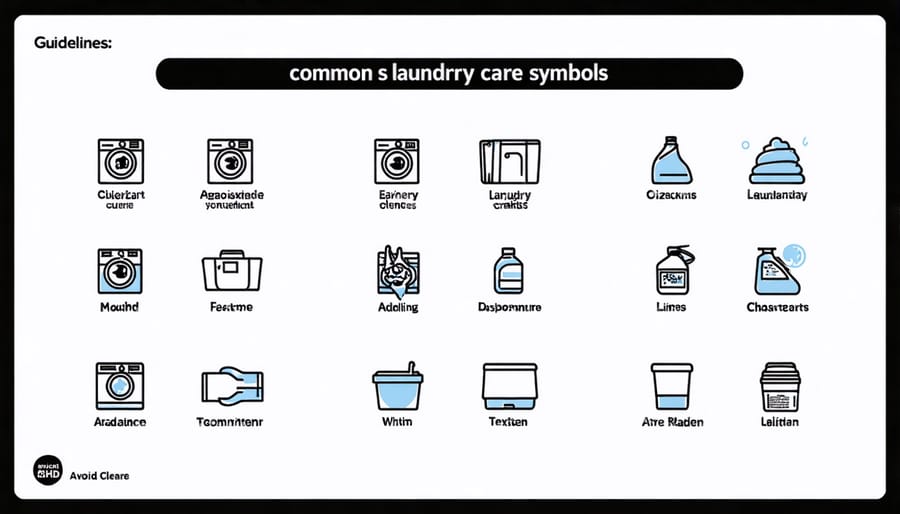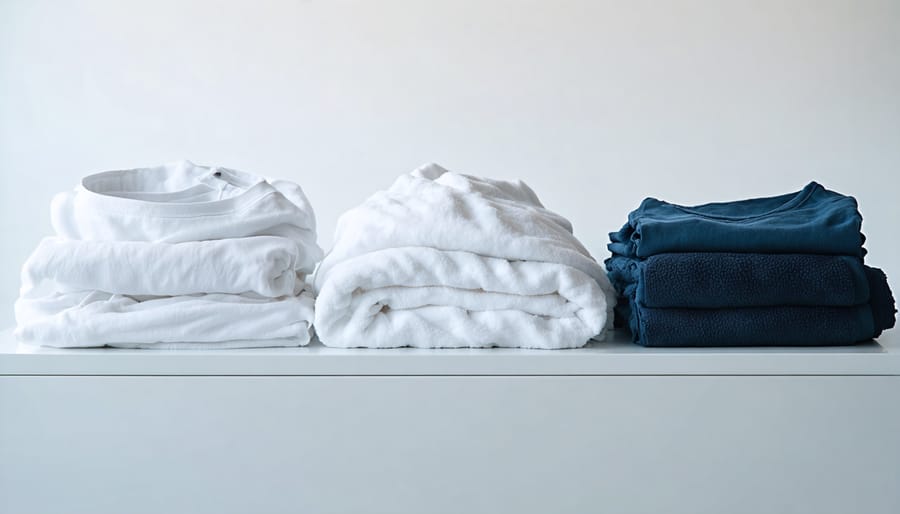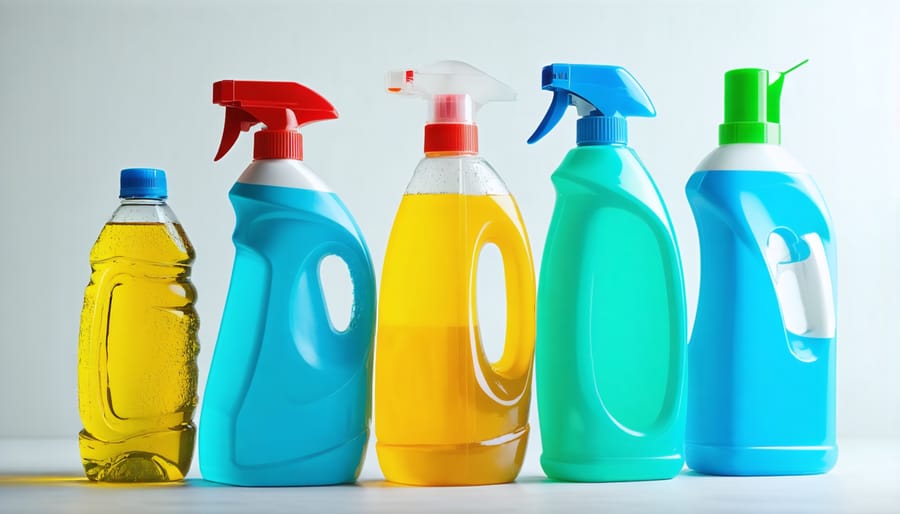Transform laundry from a dreaded chore into a simple, manageable task with these essential basics. Sort clothes by color and fabric type to protect your clothes from damage, preventing color bleeding and fabric wear. Master temperature settings based on care labels – cold water for delicates and darks, warm for everyday items, and hot for whites and heavily soiled clothes. Decode wash cycles with confidence: regular for sturdy cottons, permanent press for synthetic fabrics, and delicate for fine materials. Whether you’re tackling your first load or seeking to improve your laundry skills, these fundamental techniques ensure clean, fresh-smelling clothes while preserving their quality and extending their lifespan. From sorting to cycle selection, mastering these basics transforms laundry from overwhelming to effortless.
Understanding Laundry Symbols and Care Labels

Common Washing Symbols
Understanding laundry symbols is like learning a new language, but don’t worry – we’ll break down the most common ones you’ll encounter. For washing temperatures, you’ll see dots inside the wash basin symbol: one dot means cold (30°C/85°F), two dots indicate warm (40°C/105°F), and three dots signal hot (50°C/120°F).
The wash cycle symbols are equally straightforward. A single line under the basin represents the permanent press cycle, perfect for everyday clothes. Two lines indicate the gentle cycle, ideal for delicates. No lines? That means regular cycle is fine.
You might also spot wavy lines inside the basin – these show the agitation level. More waves mean more aggressive washing action, while fewer waves suggest a gentler approach. A hand in the water means hand wash only, and if you see an X through the basin symbol, that item shouldn’t be washed with water at all.
Remember, these symbols are your clothes’ way of telling you exactly what they need to stay in great shape. When in doubt, opt for the gentler option to protect your garments.
Drying and Ironing Symbols
Understanding drying and ironing symbols on your clothing labels can save your garments from damage and help them last longer. For drying, look for the square symbol with a circle inside. A plain circle means tumble drying is okay, while dots inside indicate temperature settings: one dot for low heat, two for medium, and three for high heat. A crossed-out symbol means no tumble drying.
You might also spot other drying symbols like a curved line (hang dry), a horizontal line (dry flat), or two vertical lines (drip dry). These methods help preserve delicate fabrics that shouldn’t go in the dryer.
For ironing guidance, look for the iron symbol. Similar to drying, the dots inside indicate temperature: one dot for low (synthetic fabrics), two dots for medium (wool and polyester blends), and three dots for high (cotton and linen). A crossed-out iron means no ironing allowed. Some symbols show steam settings too – crossed-out dots below the iron mean no steam, while wavy lines indicate steam is safe to use.
Sorting Your Laundry Like a Pro
Color Categories
Sorting clothes by color is one of the most important essential laundry sorting tips to prevent color bleeding and keep your clothes looking fresh. Start by separating your laundry into three main color categories: whites, lights, and darks.
Whites should include pure white items like undershirts, socks, and towels. Keep them separate to maintain their brightness and prevent discoloration. Light-colored clothes, including pastels, beige, and light gray items, can typically be washed together. Dark clothes encompass black, navy, red, and other deep colors that might bleed during washing.
For new clothes, especially dark-colored items or vibrant reds, wash them separately for the first few cycles. These items tend to release excess dye initially, which could stain other clothes. If you’re unsure about an item’s colorfastness, test it by dabbing a hidden area with a damp white cloth. If color transfers to the cloth, wash the item separately.
When in doubt, err on the side of caution and wash items separately. While it might mean running an extra load, it’s better than risking damage to your favorite clothes.

Fabric Types
Understanding different fabric types is key to proper laundry care. Let’s break down the main categories and how to handle them:
Cotton and Linen: These natural fibers are durable and can typically handle hot water and high heat. Wash similar colors together, as cotton tends to bleed dye. For best results, turn items inside out to prevent wear.
Synthetics: Polyester, nylon, and spandex need gentle care. Use warm or cool water and dry on medium heat to prevent damage. These materials are prone to static, so consider using fabric softener or dryer sheets.
Delicates: Silk and wool require special attention. Always use cold water and the delicate cycle. Better yet, hand wash these items when possible. Never put them in the dryer – lay flat to dry instead.
Blended Fabrics: Many modern clothes combine different materials. Always check the care label and follow the instructions for the most delicate fabric in the blend. When in doubt, use cooler temperatures and gentler cycles.
Remember to sort your laundry by both color and fabric type. This prevents damage from friction between heavy and lightweight materials and ensures each item gets the right care it needs.
Choosing the Right Water Temperature
Choosing the right water temperature can make a huge difference in how well your clothes are cleaned and how long they last. Let’s break down the best temperature choices for different situations.
Hot water (130°F or above) is your go-to for whites, heavily soiled items, and killing bacteria. It’s perfect for cotton bed sheets, towels, and workout clothes that need deep cleaning. However, be careful – hot water can shrink, fade, or damage delicate fabrics.
Warm water (90°F to 110°F) is the most versatile choice and works well for most everyday laundry. It’s ideal for synthetic fabrics, jeans, and moderately soiled clothing. Warm water helps remove body oils and dirt while being gentle enough to prevent damage to most fabrics.
Cold water (60°F to 80°F) is best for dark or bright colors, delicate items, and clothes that might shrink. It’s also an energy-efficient option that helps preserve fabric colors and is perfect for items labeled “wash in cold water only.” For tough stains, pre-treat them before washing in cold water.
Pro tip: When in doubt, check the care label! Some general rules to remember:
– Use hot water for whites and sanitizing
– Choose warm water for regular, everyday loads
– Opt for cold water for delicates and dark colors
– Consider cold water for energy savings and environmental benefits
Remember that modern detergents are designed to work effectively in all water temperatures, so you can feel confident using cold water for most loads while saving energy and protecting your clothes.
Detergent Types and Usage

Powder vs. Liquid vs. Pods
When it comes to laundry detergent, you’ve got three main choices: powder, liquid, or pods. Each has its own strengths, and knowing when to use which can make a real difference in your laundry results.
Powder detergent is often the most economical choice and works exceptionally well on outdoor stains and whites. It’s also fantastic for hard water areas since it contains more powerful water-softening agents. However, it can sometimes leave residue if not fully dissolved in cold water.
Liquid detergent is the versatile all-rounder. It dissolves easily in any temperature and works great for pretreating stains – just dab a little directly on the spot before washing. It’s particularly effective on oil-based and food stains, making it perfect for everyday laundry needs.
Pods offer convenience and precise measurements, eliminating the guesswork of how much detergent to use. They’re ideal for shared laundry facilities or when you’re on the go. While they tend to be pricier, many people find the convenience worth the extra cost. For those interested in eco-friendly laundry solutions, both powder and liquid options are available in environmentally conscious formulations.
Measuring for Perfect Results
Getting the right amount of detergent is crucial for clean, fresh-smelling laundry. Too much can leave residue on your clothes, while too little won’t clean effectively. Start by checking your machine’s manual for load capacity – most standard washers handle 12-16 pounds of laundry.
For a full load, use the detergent cap’s fill line as your guide. Most modern detergents have concentrated formulas, so you rarely need to fill the cap completely. For medium loads, fill to the middle line, and for small loads, use just a quarter cap. If you’re using powder detergent, follow the same principle with the measuring scoop provided.
Pro tip: When in doubt, use less rather than more. You can always run another cycle, but using excess detergent can be hard to rinse out. For heavily soiled loads, add just a small amount extra rather than doubling the dose.
Consider water hardness too – harder water requires slightly more detergent, while soft water needs less. Keep a measuring cup near your detergent for consistent results, and adjust based on how clean your clothes come out after washing.
Common Laundry Mistakes to Avoid
Even experienced laundry-doers make mistakes sometimes, but knowing what to avoid can help keep your clothes looking their best. Let’s explore some common laundry pitfalls and how to sidestep them.
Overloading the washing machine is a frequent mistake that can prevent clothes from getting properly clean. Your clothes need room to move around in the drum – aim to fill it about three-quarters full for optimal results.
Using too much detergent is another common error. More soap doesn’t mean cleaner clothes; excess detergent can leave residue and actually attract dirt. Follow the measurement guidelines on your detergent bottle, and consider using less for smaller loads.
Many people forget to zip zippers and empty pockets before washing. Unzipped zippers can snag delicate items, while forgotten tissues can create a frustrating mess. Take a moment to check all garments before they go in the wash.
Ignoring care labels is a costly mistake that can shrink or damage your favorite clothes. Those tiny symbols provide crucial information about water temperature, drying methods, and special care instructions.
Leaving wet clothes in the washer is another common error. This can lead to mildew and that dreaded musty smell. Try to transfer clothes to the dryer promptly, or hang them to dry within an hour of washing.
Finally, don’t skip sorting your laundry. Washing everything together might save time, but it can lead to color bleeding, fabric damage, and diminished cleaning effectiveness. Take the extra few minutes to separate lights, darks, and delicates.
Special Care Instructions
Certain garments and fabrics require extra attention to maintain their quality and extend their lifespan. For delicate items like silk blouses, lace undergarments, and wool sweaters, always use the gentle or delicate cycle with cold water. Consider using mesh laundry bags to protect these items from tangling or snagging during the wash cycle.
Cashmere and wool items should be hand-washed when possible, using lukewarm water and specialized wool detergent. Gently squeeze the water through the fabric without wringing or twisting, which can damage the fibers. Lay these items flat to dry on a clean towel, reshaping them while damp.
For silk items, use a mild detergent specifically formulated for delicates. Avoid hanging wet silk garments, as this can distort their shape. Instead, roll them in a clean towel to remove excess water, then lay flat to dry away from direct sunlight.
Lingerie and delicate undergarments should always be washed in mesh bags on a gentle cycle. Hook any bra clasps before washing to prevent snagging other items. Never put these items in the dryer – always air dry.
Athletic wear with moisture-wicking properties should be washed in cold water and air-dried when possible. Avoid using fabric softeners on these items as they can compromise the moisture-wicking ability of the fabric.
For embellished clothing with sequins or beading, turn the garment inside out before washing. Use cold water and the gentlest cycle available, or consider hand washing if the care label recommends it. Skip the dryer and lay flat or hang to dry, depending on the fabric weight.
Remember to always check the care label first, as some delicate items may be dry clean only.
Mastering laundry basics doesn’t have to be overwhelming. By following the fundamental principles we’ve covered – from sorting clothes properly to understanding care labels and choosing the right water temperature – you’ll be well-equipped to keep your clothes clean, fresh, and lasting longer. Remember that successful laundry care is all about developing good habits: checking pockets before washing, treating stains promptly, and not overloading the machine.
Start small by implementing these practices one at a time, and soon they’ll become second nature. Pay special attention to fabric care labels, use appropriate detergent amounts, and always separate lights from darks. These simple steps will help prevent common mishaps like color bleeding, shrinkage, and fabric damage.
Most importantly, don’t be afraid to make mistakes – they’re part of the learning process. With time and practice, you’ll develop an intuitive understanding of your laundry needs. Keep this guide handy as a reference, and you’ll be handling your laundry like a pro in no time. Here’s to cleaner, fresher, and better-maintained clothes!
